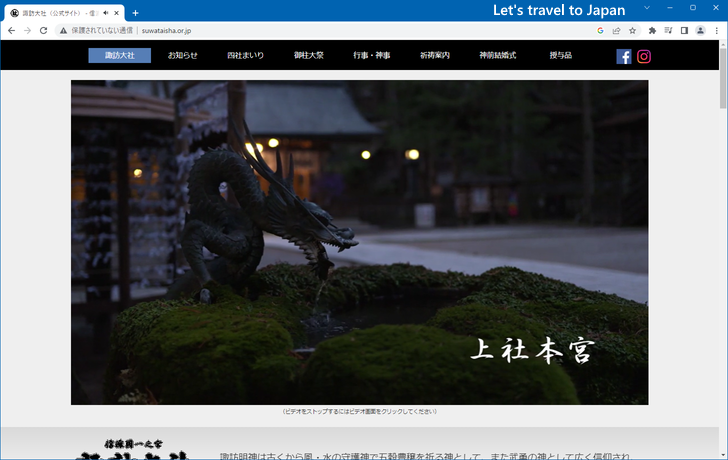Highlights and access methods of Suwa Taisha Shrine (Nagano Prefecture)
In this article, we will explain the attractions of Suwa Taisha Shrine in Nagano Prefecture and how to access it for those who are traveling to Japan from overseas.

(Last modified: )
(Prefecture : Nagano , Category : Shrines)
Table of contents
About Suwa Taisha Shrine
Suwa Taisha, also known as Suwa Grand Shrine, is a prominent Shinto shrine complex in Nagano Prefecture, consisting of four main shrines spread across two sites, the Upper Shrine (Kamisha) and Lower Shrine (Shimosha). Established over 1,200 years ago, it holds significant spiritual and historical importance in Japan. The shrine is dedicated to the deity Takeminakata-no-Kami, who is revered for his association with nature, agriculture, and warfare. Suwa Taisha is renowned for its biennial Onbashira Festival, a lively and centuries-old event involving the transportation and erection of massive wooden logs, symbolizing the renewal of the shrine and its deep connection to the surrounding natural environment.
Highlights of Suwa Taisha Shrine
Suwa Taisha, or Suwa Grand Shrine, offers international tourists a unique and immersive experience into the rich history and spiritual traditions of Japan. As one of the oldest and most significant Shinto shrines in the country, Suwa Taisha provides a glimpse into the sacred customs and beliefs that have shaped Japanese culture for centuries.
Visitors can explore the expansive grounds of the shrine complex, which is split into two sites, the Upper Shrine (Kamisha) and Lower Shrine (Shimosha). The tranquil, serene atmosphere, combined with the beautiful architecture of the shrine buildings, creates a truly memorable experience. While strolling through the wooded paths and picturesque landscape, tourists can appreciate the deep connection between Shintoism and the natural environment.
Suwa Taisha is particularly famous for its biennial Onbashira Festival, which takes place in the years of the Monkey and the Tiger, according to the Chinese zodiac. This vibrant, centuries-old event involves the transportation and erection of massive wooden logs, symbolizing the renewal of the shrine. The festival is a spectacular display of the local community's dedication to their traditions and offers a unique opportunity for visitors to witness an authentic Japanese cultural experience.
While Suwa Taisha can be visited year-round, the best time to experience the shrine in its full splendor is during the Onbashira Festival, which typically occurs in April and May. However, if you are unable to visit during the festival, the autumn months of October and November also offer a beautiful backdrop, as the foliage surrounding the shrine erupts in vibrant shades of red, orange, and yellow.
In summary, Suwa Taisha is a must-visit destination for tourists seeking to explore the spiritual and cultural traditions of Japan. The serene atmosphere, stunning architecture, and the opportunity to witness the lively Onbashira Festival make it a truly unforgettable experience.
Address and access method of Suwa Taisha Shrine
Suwa Taisha, or Suwa Grand Shrine, is located in Suwa City, Nagano Prefecture, Japan. The shrine complex is divided into two main areas: the Upper Shrine (Kamisha) and the Lower Shrine (Shimosha). Here are the addresses for both sites:
Upper Shrine (Kamisha):
Honmiya: 1 Takashima, Suwa City, Nagano Prefecture, 392-0011, Japan
Maemiya: 5799 Toyoda, Suwa City, Nagano Prefecture, 392-0011, Japan
Lower Shrine (Shimosha):
Harumiya: 2212 Miyagawa, Shimosuwa Town, Suwa District, Nagano Prefecture, 393-0085, Japan
Akimiya: 5606 Shimosuwa, Shimosuwa Town, Suwa District, Nagano Prefecture, 393-0085, Japan
As for the nearest train stations, they differ depending on which part of the shrine complex you plan to visit:
For the Upper Shrine (Kamisha), the nearest train station is Kami-Suwa Station, which is served by the JR Chuo Main Line. From the station, both the Honmiya and Maemiya sites are within walking distance, approximately 15-20 minutes away.
For the Lower Shrine (Shimosha), the nearest train station is Shimo-Suwa Station, also on the JR Chuo Main Line. Harumiya is about a 15-minute walk from the station, while Akimiya is about a 30-minute walk away.
In both cases, you can also take a bus or taxi from the respective train stations to reach the shrine sites more conveniently.
Lower Shrine (Shimosha) : Akimiya
Upper Shrine (Kamisha) : Honmiya
Attractions near Suwa Taisha Shrine
There are several interesting tourist attractions near Suwa Taisha that are worth exploring. Some of the highlights include:
Suwa Garan
Located near the Upper Shrine (Kamisha), Suwa Garan is a complex of Buddhist temples with a history dating back over 1,000 years. The beautiful architecture and serene atmosphere make it a perfect complement to your visit to Suwa Taisha.
Takashima Castle
Also known as the "Floating Castle," Takashima Castle is situated on a small hill overlooking Lake Suwa. The castle features a museum showcasing the history of the Suwa region and offers fantastic panoramic views of the lake and surrounding area.
Suwa City Museum
This museum, located near Lake Suwa, focuses on the history, culture, and natural environment of the Suwa region. It provides an interesting insight into the local traditions, including the Onbashira Festival and the development of the local hot springs.
Hot Springs (Onsen)
The Suwa area is known for its abundance of hot springs, with several onsen towns nearby, such as Shimosuwa Onsen and Kami-Suwa Onsen. These hot springs offer a relaxing and rejuvenating experience, with many ryokan (traditional Japanese inns) and public bathhouses to choose from.
These attractions, along with Suwa Taisha, provide a diverse and enriching experience for visitors, showcasing the region's natural beauty, history, and cultural heritage.
Other information about Suwa Taisha Shrine
Official site (Japanese only) about Suwa Taisha Shrine :

-- --
Thank you for reading to the end.
( Written by Tatsuo Ikura )